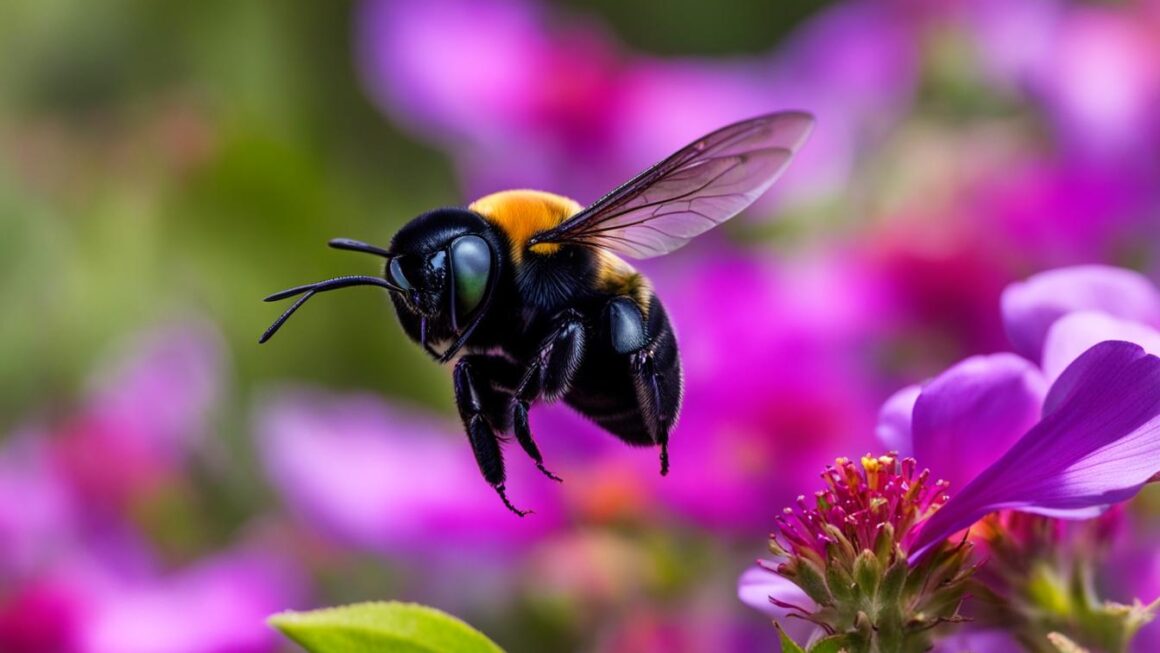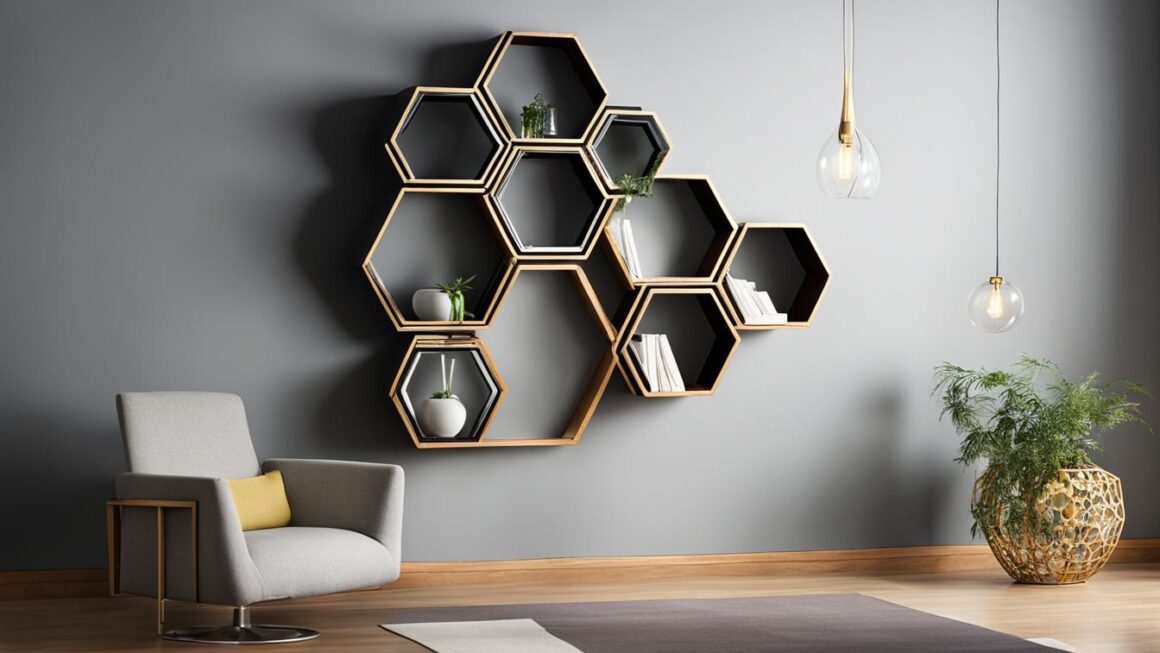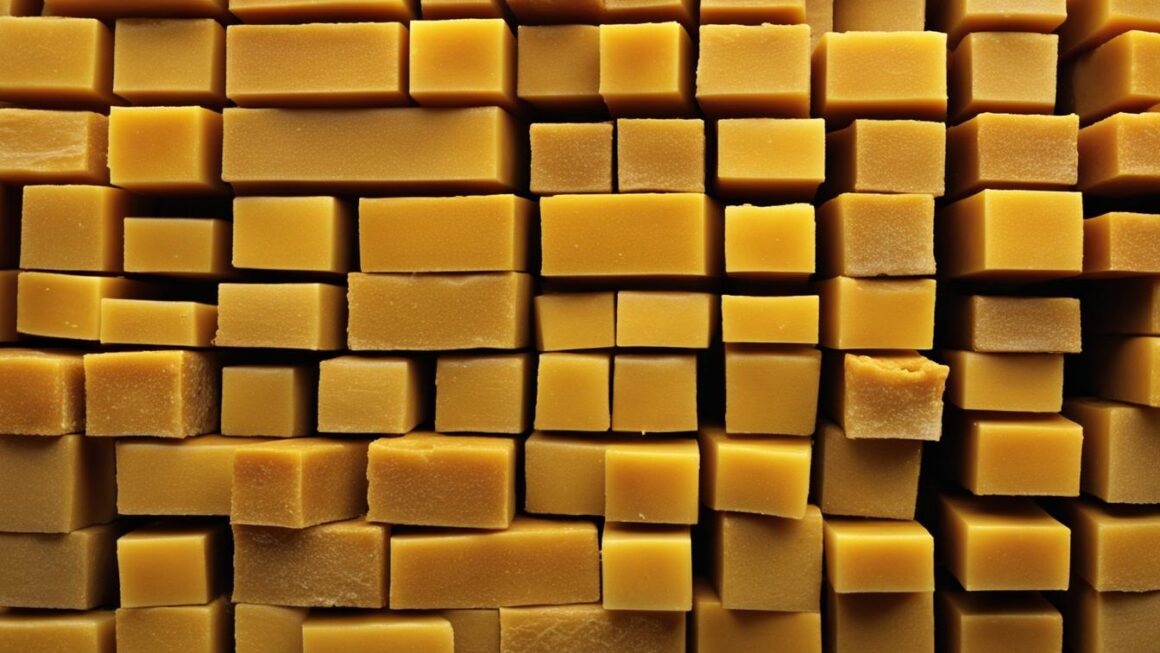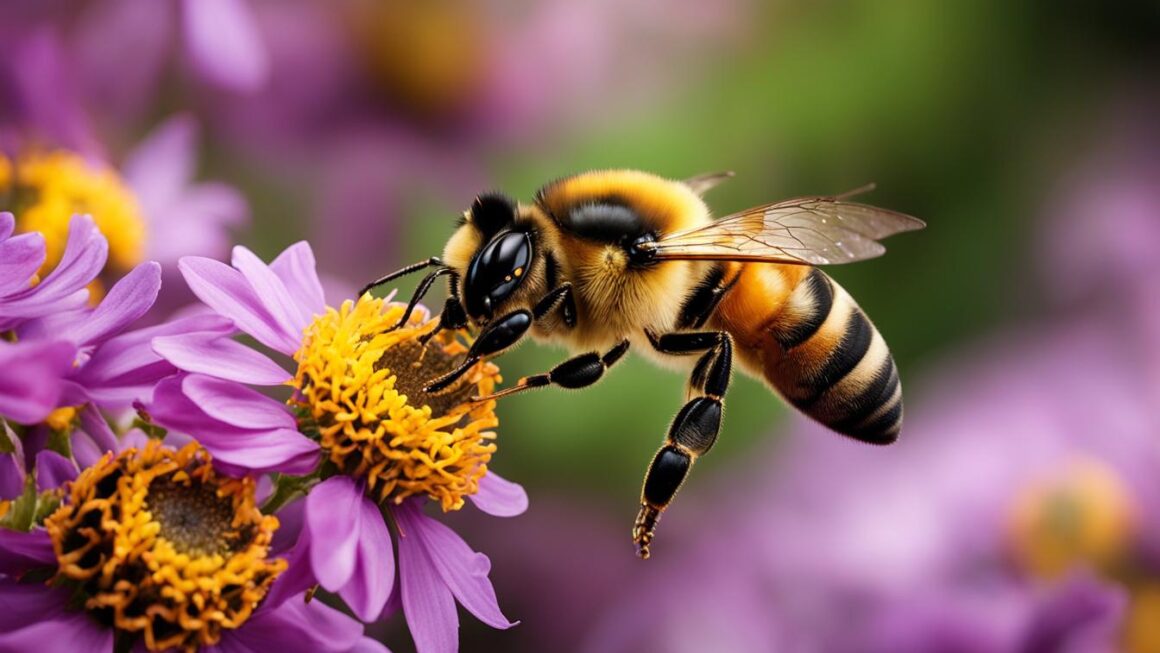Carpenter bees can cause significant damage to wooden structures. To attract and trap carpenter bees effectively, consider using carpenter bee traps made with softer and untreated wood. Hang the traps in strategic locations, such as high up on the eaves of your house or alongside porch corners. Use carpenter bee bait, like Best Bee Brother’s Bait, to attract the bees into the traps. Additionally, create a sugar solution and place it inside the trap to further entice the bees. Check the traps regularly and remove any trapped bees. Putting out the traps at the beginning of spring, when carpenter bees are most active, will yield the best results.
Key Takeaways:
- Choose carpenter bee traps made with softer and untreated wood
- Hang the traps in strategic locations, such as eaves and porch corners
- Use carpenter bee bait and a sugar solution to attract the bees
- Check the traps regularly and remove trapped bees
- Place traps at the beginning of spring for optimal results
Carpenter bees can cause significant damage to wooden structures. To attract and trap carpenter bees effectively, consider using carpenter bee traps made with softer and untreated wood. Hang the traps in strategic locations, such as high up on the eaves of your house or alongside porch corners. Use carpenter bee bait, like Best Bee Brother’s Bait, to attract the bees into the traps. Additionally, create a sugar solution and place it inside the trap to further entice the bees. Check the traps regularly and remove any trapped bees. Putting out the traps at the beginning of spring, when carpenter bees are most active, will yield the best results.
Key Takeaways:
- Choose carpenter bee traps made with softer and untreated wood
- Hang the traps in strategic locations, such as eaves and porch corners
- Use carpenter bee bait and a sugar solution to attract the bees
- Check the traps regularly and remove trapped bees
- Place traps at the beginning of spring for optimal results
How Do Carpenter Bee Traps Work?
Carpenter bee traps are a highly effective method for capturing and controlling these destructive insects. These traps are designed to mimic potential nesting sites for carpenter bees, enticing them to enter and become trapped. The traps are typically made of pre-drilled wooden boxes or tunnels that resemble the natural nesting holes that carpenter bees prefer. Some traps even incorporate transparent materials, such as glass containers or plastic bottles, to create the illusion of an exit, tricking the bees into becoming trapped.
Once inside the trap, the carpenter bees are unable to fly out and are effectively captured. This method allows for safe and chemical-free removal of carpenter bees without harming other beneficial insects. It is important to note that while traps effectively capture adult carpenter bees, they do not prevent fresh eggs from hatching. Regular monitoring and removal of trapped bees is necessary to prevent further infestation.
One way to enhance the effectiveness of carpenter bee traps is to use DIY carpenter bee lures and repellents. These homemade baits can be added to the traps to attract more carpenter bees. Additionally, strategically placing the traps in areas where carpenter bees are likely to nest, such as high up on the eaves of your house or alongside porch corners, can increase their success rate.
Table: Pros and Cons of Carpenter Bee Traps
| Pros | Cons |
|---|---|
| Effective at capturing adult carpenter bees | Do not prevent fresh eggs from hatching |
| Safe and chemical-free solution | Requires regular monitoring and removal of trapped bees |
| Can be enhanced with DIY carpenter bee lures | May not capture all carpenter bees in the area |
DIY carpenter bee traps are an affordable and environmentally-friendly solution for controlling carpenter bee infestations. By imitating the bees’ natural nesting sites, these traps effectively lure and capture adult bees without the use of harmful chemicals. Regular monitoring is key to ensure the traps remain effective and prevent further infestations. Implementing traps in combination with other carpenter bee control strategies can help protect your wooden structures and maintain a pest-free environment.
Overall, carpenter bee traps are a valuable tool in controlling carpenter bee populations and protecting your property from damage. When paired with other preventative measures, such as sealing existing nests and providing alternative nesting options, carpenter bee traps can help ensure a pest-free and harmonious environment.
When To Put Out Carpenter Bee Traps
If you want to attract carpenter bees to your traps, it’s crucial to know the right time to put them out. The best time to hang the traps is at the beginning of spring when carpenter bees are most active. During this period, the bees are busy mating and constructing nests, making them more likely to be attracted to the traps.
By placing the traps early in the season, you can prevent the bees from burrowing into your wood and redirect them to the traps instead. It’s important to choose strategic locations for the traps that are easily visible and accessible to the bees. This will increase the chances of the bees noticing and entering the traps.
Remember that carpenter bees are attracted to warmth, so hanging the traps in sunny areas will make them more effective. However, avoid placing the traps under a rafter, as carpenter bees tend to ignore them in those locations. By timing the placement of the traps correctly and positioning them in the right spots, you can greatly enhance your chances of successfully attracting carpenter bees.
When To Put Out Carpenter Bee Traps
| Month | Temperature | Carpenter Bee Activity |
|---|---|---|
| March | 50-60°F | Increasing activity, mating begins |
| April | 60-70°F | Peak activity, nest construction |
| May | 70-80°F | Continued activity, nest completion |
“Placing carpenter bee traps at the beginning of spring is crucial for effective trapping. By aligning the traps with the peak activity of carpenter bees, you can significantly increase the chances of attracting and capturing these pests.” – Pest Control Expert
Putting out carpenter bee traps at the right time is essential for successful trapping. By understanding the bees’ behavior and timing, you can take proactive steps to protect your wooden structures from damage caused by carpenter bees. Remember to check the traps regularly and remove any trapped bees to maintain the traps’ effectiveness throughout the season.
Where To Hang Carpenter Bee Traps
Placement of carpenter bee traps is crucial to effectively attract and trap these bees. By strategically hanging the traps in the right locations, you can maximize their effectiveness and minimize the damage caused by carpenter bees. Here are some key tips for where to hang your carpenter bee traps:
- Hang the traps high up on the eaves of your house: Carpenter bees are attracted to warmth, so placing the traps in sunny areas on the eaves of your house will increase their visibility and lure the bees towards them.
- Hang the traps alongside the corners of your porch: Carpenter bees tend to prefer nesting in sheltered spots, making porch corners an ideal location for traps. Ensure the traps are easily visible and accessible to the bees.
- Avoid hanging the traps under a rafter: Carpenter bees often ignore traps placed directly under a rafter. Instead, choose locations where the traps will be more noticeable and enticing to the bees.
- Consider placing traps near existing carpenter bee nests: If you have identified sealed carpenter bee nests on your property, hanging traps near them can redirect bees away from your wooden structures and towards the traps.
By following these placement guidelines, you can increase the chances of attracting carpenter bees to your traps and effectively controlling their population.
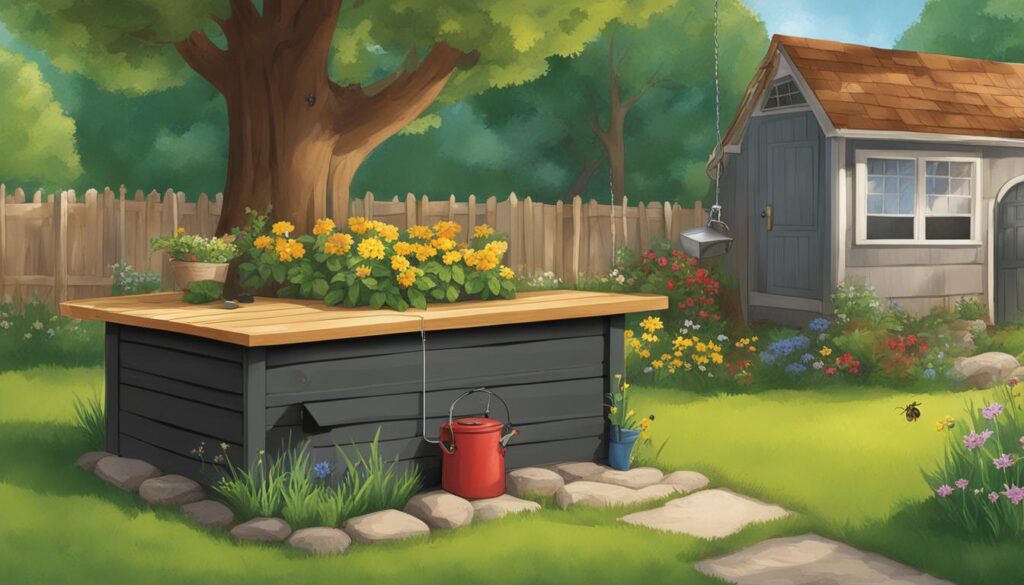
Table: Optimal Locations for Carpenter Bee Trap Placement
| Location | Description |
|---|---|
| High up on the eaves of your house | Sunny areas on the eaves of your house attract warmth-seeking carpenter bees |
| Alongside the corners of your porch | Sheltered spots where carpenter bees prefer nesting |
| Avoid hanging under a rafter | Carpenter bees tend to ignore traps in these locations |
| Place near existing carpenter bee nests | Redirect bees away from wooden structures and towards the traps |
What To Put Inside Carpenter Bee Trap
When setting up a carpenter bee trap, it is important to use the right bait to attract the bees. One effective homemade carpenter bee solution is a sugar solution made by mixing equal parts sugar and water. This sweet mixture mimics the nectar that carpenter bees typically feed on. Place a small amount of the sugar solution inside the trap to entice the bees to enter.
In addition to the sugar solution, consider using a combination of citrus oil and almond oil diluted with water. This mixture can be sprinkled around the trap to create a scent that carpenter bees find unappealing. By deterring the bees from nesting in the vicinity of the trap, you can increase the chances of them entering the trap instead. Remember to reapply the mixture regularly to maintain its effectiveness.
It is important to note that if you have existing carpenter bee nests, they should be properly sealed before hanging the traps. Otherwise, the bees may continue to nest in the untreated wood of your home. To encourage the bees to leave the nests, you can try playing loud music or creating vibrating sounds near the area. This disturbance can prompt the bees to seek alternative nesting sites, such as the traps you have set up.
| Bait | Instructions |
|---|---|
| Sugar Solution | Mix equal parts sugar and water. Place a small amount inside the trap. |
| Citrus and Almond Oil Mixture | Dilute citrus oil and almond oil with water. Sprinkle around the trap to create a deterrent scent. |
| Sealing Existing Nests | Properly seal any existing carpenter bee nests to redirect the bees to the traps. |
By using these homemade carpenter bee solutions and following the proper techniques for trapping and deterring the bees, you can effectively get rid of carpenter bees and protect your wooden structures.
Tips for Effective Carpenter Bee Trapping and Attracting Carpenter Bees
If you find that your carpenter bee traps are not yielding the desired results, there are several tips and techniques you can try to enhance their effectiveness. These strategies can help increase the chances of attracting carpenter bees and successfully trapping them.
Optimal Trap Placement
The placement of your carpenter bee traps is crucial for attracting these buzzing insects. To maximize their visibility, hang the traps in sunny areas such as the eaves of your house or porch corners. Carpenter bees are drawn to warmth, making these spots attractive nesting sites. Avoid placing the traps under rafters, as carpenter bees tend to ignore them in those locations. By strategically positioning the traps in high-traffic areas for carpenter bees, you can increase the likelihood of capturing them.
Utilize Carpenter Bee Bait
In addition to the design and placement of your traps, using carpenter bee bait can significantly enhance their effectiveness. Carpenter bees are naturally attracted to certain scents and materials, and baiting the traps with these attractants can make them more enticing. Consider using commercially available carpenter bee baits or even creating homemade baits using natural ingredients that mimic the bees’ preferred nesting materials. Experimenting with different bait options can help you discover what works best in attracting carpenter bees to your traps.
“Placing a dead carpenter bee inside the trap can also be highly effective in luring new bees in.”
Check for Active Nests
If your carpenter bee traps are still not producing results, it’s essential to check for active nests in your vicinity. Carpenter bees may have established nests in untreated wood around your property, which could be diverting their attention from the traps. Identify and seal any active nests before hanging the traps. This will redirect the bees to the traps and increase the likelihood of successful trapping.
| Bait Option | Effectiveness |
|---|---|
| Commercial Carpenter Bee Bait | Highly effective |
| Homemade Bait | Varies depending on ingredients used |
| Dead Carpenter Bee | Highly effective |
By implementing these tips, you can optimize your carpenter bee trapping efforts and increase your chances of success. Remember to regularly check and maintain the traps, removing any captured bees promptly. For persistent issues, consider consulting a professional exterminator who can provide expert advice tailored to your specific situation. With patience and perseverance, you can effectively control carpenter bee populations and protect your property.

Should You Paint or Stain Carpenter Bee Traps?
When it comes to preserving and protecting your carpenter bee traps, it is important to consider whether or not to paint or stain them. While it may be tempting to add a decorative touch or match them to your existing outdoor decor, it is not recommended to paint or stain carpenter bee traps.
Carpenter bees are naturally attracted to soft, untreated wood, and paints or stains containing volatile organic compounds (VOCs) can deter them. These chemicals can create a strong scent that may discourage the bees from entering the traps. Instead, it is best to leave the traps in their natural state, as the bees are more likely to be attracted to the traps if they resemble their preferred nesting sites.
By leaving the carpenter bee traps untreated, you are also ensuring that the traps are made from softer wood. This type of wood is easier for the bees to burrow into, increasing the effectiveness of the traps. Stains or paints can create a barrier on the surface of the wood, making it more difficult for the bees to penetrate and enter the traps.
“Paints or stains containing volatile organic compounds (VOCs) can deter carpenter bees from entering the traps.”
Preserving the natural look and feel of the carpenter bee traps also helps to maintain their longevity. Over time, painted or stained traps may begin to chip or flake, requiring regular maintenance. By leaving the traps untreated, you can minimize the need for ongoing touch-ups and ensure that they remain effective in attracting and trapping carpenter bees.
In conclusion, it is best to preserve and protect your carpenter bee traps by leaving them in their natural state. Avoid painting or staining the traps, as these can deter carpenter bees from entering. By maintaining the traps with softer, untreated wood, you can increase their effectiveness and longevity, ensuring that they continue to attract and trap carpenter bees for seasons to come.
| Pros | Cons |
|---|---|
|
|
The Importance of Carpenter Bees in Pollination
Carpenter bees, despite their reputation for causing damage to wooden structures, play a crucial role in pollination. As pollinators, they contribute to the reproduction and survival of many plant species. While honey bees often receive the most attention, a diverse population of wild bees, including carpenter bees, is essential for maintaining a healthy ecosystem.
Carpenter bees are particularly adept at pollinating certain crops, such as eggplants and tomatoes. They gather nectar and pollen from flowers, inadvertently transferring pollen from the male parts of the flower to the female parts, allowing for fertilization and the production of seeds and fruits. The efficient pollination provided by carpenter bees helps ensure the genetic diversity and abundance of plant species, which in turn supports other wildlife and ecosystems.
Protecting wild bee populations, including carpenter bees, is vital for maintaining biodiversity and sustaining food production. To discourage carpenter bees from nesting in your home, consider painting your wood with a protective coating and treating it with almond oil, as the scent is disliked by carpenter bees. Providing alternative nesting options, such as untreated pine or cedar elements in your garden, can attract carpenter bees away from your house while promoting their important role as pollinators.
Conclusion
In conclusion, implementing effective methods to attract and control carpenter bees can help prevent damage to your wooden structures while protecting the environment. Using carpenter bee traps made from softer and untreated wood, strategically placing them in areas where the bees are likely to notice, and using bait such as sugar solution can successfully lure and trap the bees. Regular monitoring and removal of trapped bees is essential to maintain the traps’ effectiveness.
It is important to note that painting or staining the carpenter bee traps is not recommended, as it may deter the bees from entering. Preserving the traps in their natural state can help attract carpenter bees and increase the success rate of trapping them.
Furthermore, taking steps to preserve wild bee populations and providing alternative nesting options in your garden can contribute to the overall health of the ecosystem. Regularly painting wooden structures, treating them with almond oil, and offering untreated pine or cedar elements for nesting can help deter carpenter bees from nesting in your home.
By following these guidelines and incorporating these strategies, you can effectively control carpenter bees without causing harm to your property or the environment. Remember, attracting and trapping carpenter bees requires patience and consistent monitoring, but the results will be worth it in the long run.
FAQ
How do carpenter bee traps work?
Carpenter bee traps imitate potential nesting sites for carpenter bees. The traps are pre-drilled wooden boxes or tunnels that trick the bees into entering. Once inside, the bees are unable to fly out and become trapped. Some traps can be attached to glass containers or plastic bottles, where the transparent material tricks the bees into thinking it is an exit, but they end up becoming stuck in the trap.
When should I put out carpenter bee traps?
It is best to put out carpenter bee traps at the beginning of spring when carpenter bees are most active. By having traps in place early on, you can prevent the bees from burrowing into your wood and redirect them to the traps instead.
Where should I hang carpenter bee traps?
The best places to hang carpenter bee traps are high up on the eaves of your house and alongside the corners of your porch. Carpenter bees are attracted to warmth, so hanging the traps in sunny areas will increase their effectiveness. Avoid hanging the traps under a rafter, as carpenter bees tend to ignore them in those locations.
What should I put inside a carpenter bee trap?
To attract carpenter bees to your trap, create a sugar solution by mixing equal parts sugar and water. Place a small amount of the solution inside the trap. Carpenter bees are naturally drawn to these traps because they resemble nests, but the addition of the sugar water further entices them.
My carpenter bee traps aren’t working. What should I do?
If your carpenter bee traps are not working, ensure that you have placed them in optimal positions where the bees are likely to notice them. Mimic their natural nesting habitat, and consider using carpenter bee bait to attract the bees to the traps. Placing a dead carpenter bee inside the trap can also be highly effective in luring new bees in. If you are still not seeing results, check for any active nests and seal them up before hanging the traps. It may be beneficial to consult a professional exterminator for additional assistance.
Should I paint or stain carpenter bee traps?
It is not recommended to paint or stain carpenter bee traps. Carpenter bees are attracted to soft, natural wood, and stains or paints containing volatile organic compounds (VOCs) can deter them. To preserve and protect your carpenter bee traps, it is best to leave them in their natural state.
What is the importance of carpenter bees in pollination?
Carpenter bees play an important role in pollination. They are particularly skilled at pollinating certain crops, such as eggplants and tomatoes. While honey bees often receive more attention, a diverse population of wild bees, including carpenter bees, is crucial for maintaining a healthy ecosystem.

